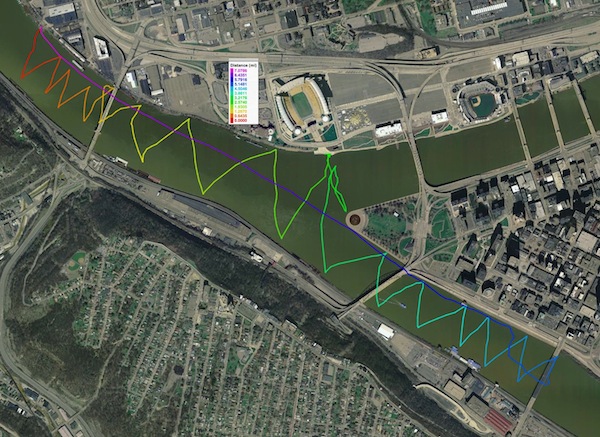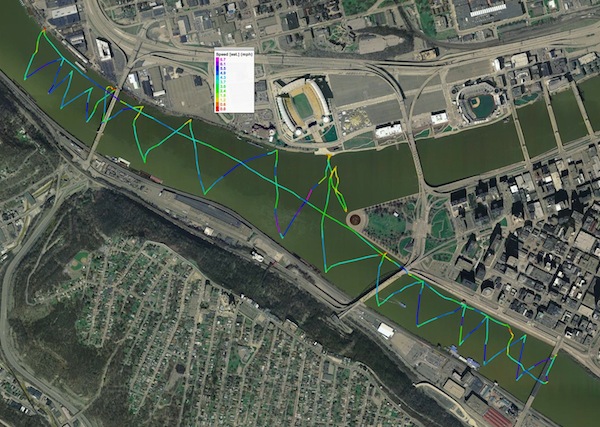Perfect Sailing
September 3, 2012
Today is Labor Day and that means that my season of sailing on the rivers around Pittsburgh's Point is ending. It has been a difficult season for sailing. Time and again, I put into the water with a forecast of strong steady winds from a good direction. Time and again, the forecast is wrong. We'd end up with no wind or with the erratic winds that come when the wind is obstructed by the ridges on the Southern bank of the Ohio.
I could remember great days sailing. The winds were steady and strong. They would catch the boat and send it slicing through the water with a gurgling rush. The hull would be pressed down into the water and a foaming wake would rise to my stern. I'd fill the river with perfect zig-zags, bank to bank, as I tacked to and fro. Were these great days, I began to wonder, days past? Or worse, were they exaggerations of an over-eager imagination?
Today, it all came back. Everything was perfect. Well, not quite. It all ended with one of the more harrowing of my experiences sailing on the rivers. I'll get to that later.
Over the days leading up to Labor Day, I'd been watching the forecasts. They were steadily calling for Southeasterly winds of around 8-9 mph. Here are two picked up in the morning. (NWS, supercast). The only worry was a 50-60% chance of rain. By noon, a close look at the weather radar made clear that the chances were much less.
Later records show that the forecast was quite correct. During my sail that lasted from 3:10pm to 5:30pm, I had roughly Southeasterly winds at around 8 mph. Here's the windfinder plot
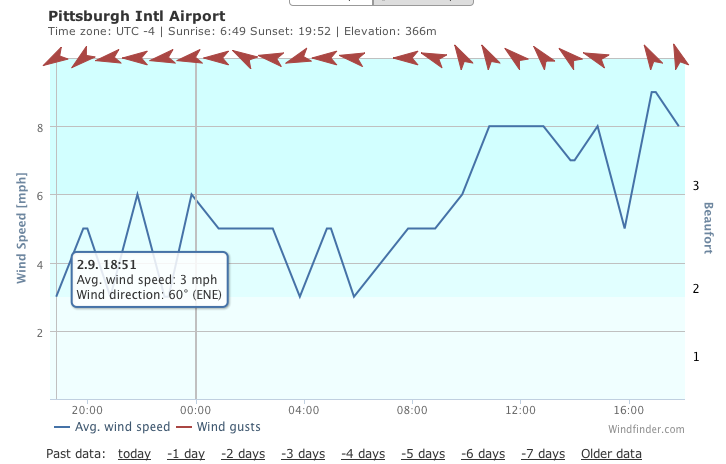
The red arrows at the top indicate wind direction. Here's the National Weather Service record. The temperatures were pleasantly warm, somewhere around 80F. As happens towards the end of summer, the river currents were too low to be of concern. Here are the flows on the Ohio, Allegheny and Mon Rivers.
Under these perfect conditions, I set off at 3:10pm. The winds were blowing steadily with the current on the Ohio River. That is what you should expect, since the Ohio is aligned roughly in that direction. I painted the river with lovely zigzag tracks, captured by my gps receiver.
Here they are, color coded for distance and speed:
The deviations from the perfect zig zag result when I need to avoid other boats on the river, not from any lack of wind. I'll explain more of that below.
By 4pm I arrived at the Point and beached at Heinz Field to stretch my legs. The rib festival is in full swing and there is a baseball game farther upstream. There's the lazy feel of the last days of summer in the air.
The sky had been gray and dreary when I put into the water. It was now a perfect summer blue.
After a short rest, I put back into the water. I did not expect that the Southeasterly winds would make it up the Allegheny River. They should be blocked by its Southeastern bank. Nonetheless I did try to sail up it.
You can see in the gps tracks that I tacked to and fro a few times trying to gain some distance. The winds were just not there. It was good. It was just what I expected. I do seem to be predicting conditions on the water fairly well.
So I turned my bows towards the Mon and had a pleasant sail, tacking back and forth past the riverboats docked along the Mon, up to the Smithfield Street Bridge. I'd planned to sail on a little farther. But at that moment, my boat was struck by the disaster I'll describe below. I turned at 4:55 pm and limped home, slowly, on a run with a sail reefed down to the smallest size that still powered the boat. I arrived with relief around 5:30 pm.
Here are some photos and some more of the story.
The mast is stepped and I am ready to slide the boat into the water.
When I arrive at the West End Bridge, I see a large barge coming. I sail over to one of the bridge pilons and furl the sail. You can just see the barge on the right.
I watch the fast moving bow of the barge pass under the bridge.
Here's the great force that drives it.
I'd drifted a little way back downstream waiting for the barge to pass. I unfurled the sail and set off again, only to find myself facing a large river boat.
To avoid sailing straight into her, I pointed my bows close enough to the wind to lose most of the lift of the sail. That meant I just crept forward slowly, while I waited for the boat to pass.
There would a lot of dodging boats today. After this one had passed, I looked downstream to see her turning to sail back to the Point.
Now here's my harrowing experience.
There a many things a sailor fears. Sea monsters. River monsters. Running aground and holing the hull. Losing the mast. The last means that you have lost your source of power and will drift at the mercy of wind and current.
In most sailboats, the mast is held in place by wires that run from high up on the mast down to the hull. They have nautical names: "shroud," "forestay," etc. In my Hobie Bravo, there are no such wires. Instead the mast is held in place by a metal cradle that takes all the strains of the mast.
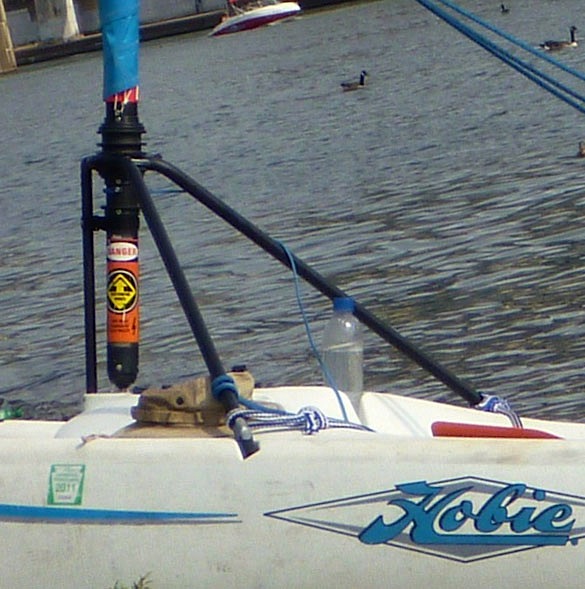
If that cradle comes loose, I will lose the mast.
Shortly after I had sailed under the Fort Pitt Bridge, as a good gust of wind took hold of the boat, I felt a clunk. I was puzzled. Had I sailed over something? I'd noticed earlier that there was a lot of bolt thread showing on the port (left) side of the cradle. Had it come loose? I shook it and it didn't budge.
I sailed on, past the docked Gateway Clipper fleet. Then, just as I completed a tack to pass the Smithfield Street Bridge, the port side of the cradle lifted from the hull. Here's how it looked, as shown in a photo taken when I had returned to the Newport Marina:
Now the mast is not properly supported. What happens next, I wondered. How much wind will it take to bring the mast down and damage the other parts of the cradle. Might it even damage the hull where the cradle attaches to it? This is a Bad Thing. It is happening in the middle of the Mon river well away from home. That makes it a Very Bad Thing.
What could I do? The first thing was to furl the sail to take the wind pressure off the mast. I turned the bows downstream towards home and let the wind at my back push me. That gave me time to think. I started to make for the shore opposite the Gateway Clipper dock. Best to keep clear of them, I thought, in case one takes to the water.
What I needed was a way to secure the mast. Fortunately I had a docking line in the Bravo's locker. I pulled it out and looped it around the stern of the Bravo's port hull. Here's how it looked:
I took the other end and tied it round the mast as tightly as I could. There was not much line spare, but I did manage a "round turn and two half hitches."
There was more movement than I liked in the stretchy line, but I hoped it would be enough to hold the mast. I let out a small triangle of sail and headed home. I was lucky, I thought, that this happened with Southeasterly winds, for they carry me home on the easiest point of sail. That is a run, with the wind at my back. It took a long 30 minutes of slow, worried sailing to make it home. I knelt on the hull and held out the mainsheet in one hand to keep the small triangle of sail full of wind. The olther hand held the tiller and pressed on the docking line to keep the line taught.
When I arrived back at the Newport Marina, I hopped off the deck and took this photo to show the whole arrangement.
After the boat had been hauled back onto its ramp, the mast had been taken down and the sail dropped, I turned to see what repair was needed. It looked like all I needed to do was remove the cover plate and screw the two retaining bolts back in place. After some scrounging for tools, I managed to do that. I was worried that I had to use some force to tighten the bolts. Were they misaligned or, worse, stripped? By the time I'd finished, everything seemed to be locked down solidly.
Is it really secure? I suppose I'll find out on my next sail.
All that was left was one other small technical achievement. I needed a bag to hold the mast. It has the sail wrapped around it and I want to protect the sail as much as possible. Last summer, I'd made a bag out of a piece of tarpaulin and duct tape. At the time, it looked like it would live forever. I now know, that duct tape has a shorter life span.
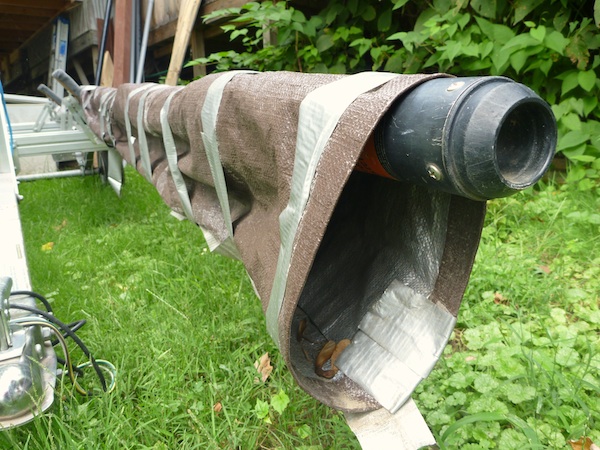
My next effort in bag manufacture involved replacing the duct tape with staples from a heavy duty stapler.
The result is far from fine craftsmanship and several feet too long.
I'm hoping that staples have a longer life than duct tape. Perhaps I'll get two years out of this one?
John D. Norton
Back to main

